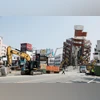Rescuers searched Thursday for dozens of people still out of contact a day after Taiwan's strongest earthquake in a quarter century damaged buildings, caused multiple rockslides and killed nine people.
In the eastern coastal city of Hualien near the epicentre, workers used an excavator to stabilise the base of a damaged building with construction materials, as some officers took samples of its exterior.
Mayor Hsu Chen-wei previously said 48 residential buildings had been damaged, some of which were tilting at precarious angles with their ground floors crushed.
Some Hualien residents were still staying in tents, but much of the island's day-to-day life was returning to normal. Some local rail service to Hualien resumed, and Taiwan Semiconductor Manufacturing Co. restarted most operations, the Central News Agency reported.
Hendri Sutrisno, a 30-year-old professor at Hualien Dong Hwa University, spent Wednesday night in a tent with his family, fearing aftershocks.
We ran out of the apartment and waited for four to five hours before we went up again to grab some important stuff such as our wallet. And then we're staying here ever since to assess the situation, he said.
More From This Section
Others also said they didn't dare to go home because the walls of their apartments were cracked and they lived on higher floors.
More than 1,050 people were injured in the quake that struck Wednesday morning. Of the nine dead, at least four were killed inside Taroko National Park, a tourist attraction famous for its scenes of canyons and cliffs in Hualien County, about 150 kilometres (90 miles) from the island's capital Taipei. One was found dead in a damaged building.
About 130 people were either still trapped or out of contact Thursday, the National Fire Agency said.
About two dozen tourists and other people were stranded in the park, while the health and welfare ministry said 64 workers were unable to leave a quarry. The quarry workers were reported Wednesday to be safe but unable to leave due to blocked and damaged roads. Six workers from another quarry were airlifted out.
Several people, including six university students, were also reported to be trapped. Around 30 people, mostly employees at the hotel earlier reported to be in the national park, were out of contact with authorities.
For hours after the quake, local television showed neighbours and rescue workers lifting residents through windows and onto the street from damaged buildings where the shaking had jammed doors shut. It wasn't clear Thursday morning if any people were still trapped in buildings.
The quake and its aftershocks caused landslides and damaged roads, bridges and tunnels. The national legislature and sections of Taipei's main airport suffered minor damage.
The quake was the strongest to hit Taiwan in 25 years. Local authorities measured the initial quake's strength as 7.2 magnitude, while the US Geological Survey put it at 7.4.
Huang Shiao-en was in his apartment when the quake struck. At first the building was swinging side to side, and then it shook up and down, Huang said.
The Central Weather Administration has recorded more than 300 aftershocks from Wednesday morning into Thursday.
Taiwan is regularly jolted by earthquakes and its population is well-prepared for them. It also has stringent construction requirements to ensure buildings are quake-resistant.
The economic losses caused by the quake are still unclear. The self-ruled island is the leading manufacturer of the world's most sophisticated computer chips and other high-technology items that are sensitive to seismic events.
Hualien was last struck by a deadly quake in 2018, which killed 17 people and brought down a historic hotel. Taiwan's worst recent quake struck on September 21, 1999, a magnitude 7.7 temblor that caused 2,400 deaths, injuring around 100,000 and destroying thousands of buildings.

)
